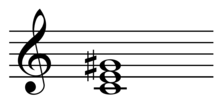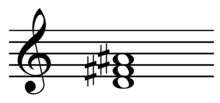- Whole tone scale
-
Whole tone scale Qualities Number of pitch classes 6 In music, a whole tone scale is a scale in which each note is separated from its neighbors by the interval of a whole step. There are only two complementary whole tone scales, both six-note or hexatonic scales:
The whole tone scale has no leading tone and because all tones are the same distance apart, "no single tone stands out, [and] the scale creates a blurred, indistinct effect".[1] This effect is especially emphasized by the fact that triads built on such scale tones are augmented. Indeed, one can play all six tones of a whole tone scale simply with two augmented triads whose roots are a major second apart. Since they are symmetrical, whole tone scales do not give a strong impression of the tonic or tonality.
The composer Olivier Messiaen called the whole tone scale his first mode of limited transposition. The composer and music theorist George Perle calls the whole tone scale interval cycle 2, or C2. Since there are only two possible whole tone scale positions (that is, the whole tone scale can be transposed only once), it is either C20 or C21. For this reason, the whole tone scale is also maximally even and may be considered a generated collection.
Due to this symmetry, the hexachord consisting of the whole-tone scale is not distinct under inversion or more than one transposition. Thus many composers have used one of the "almost whole-tone" hexachords, whose "individual structural differences can be seen to result only from a difference in the 'location,' or placement, of a semitone within the otherwise whole-tone series."[2] Alexander Scriabin's mystic chord is a primary example, being a whole tone scale with one note raised a semitone, with this alteration allowing for a greater variety of resources through transposition.[3]
Contents
Classical music
 The opening theme to Rimsky-Korsakov's Scheherazade is, "simply a descending whole-tone scale with diatonic trimmings."[4] [non-whole-tone scale notes in red].
The opening theme to Rimsky-Korsakov's Scheherazade is, "simply a descending whole-tone scale with diatonic trimmings."[4] [non-whole-tone scale notes in red].
 Play (help·info)
Play (help·info)Use of the melodic whole tone scale can be traced at least as far back as Mozart, in his Musical Joke, for strings and horns. In the 19th century Russian composers went further with melodic and harmonic possibilities of the scale, often to depict the ominous; consider the endings of the overtures to Glinka's opera Ruslan and Lyudmila and Borodin's Prince Igor, the Commander's theme in Dargomyzhsky's The Stone Guest, and the sea king's music in Rimsky-Korsakov's Sadko. (For some short piano pieces written completely in whole-tone scale, see nos. 1, 6, and 7 from V.A. Rebikov's Празднество (Une fête), Op. 38, from 1907.)
H.C. Colles names as the "childhood of the whole-tone scale" the music of Berlioz and Schubert in France and then Russians Glinka and Dargomijsky.[5] Claude Debussy, who had been influenced by Russians, along with other Impressionist composers made extensive use of whole tone scales. The whole tone scale was also used by Alban Berg in his Violin Concerto (the last four notes of the 12-tone row he used are B, C♯, E♭ and F, which, together with the first note, G, comprise 5 of the 6 notes of the scale) and by Béla Bartók in his Fifth String Quartet. Ferruccio Busoni used the whole tone scale in the right hand part of the "Preludietto, Fughetta ed Esercizio" of his An die Jugend, and Franz Liszt applied the whole tone scale to parts of the score of his Dante Symphony.
Jazz harmony
The scale is also used extensively in modern jazz writing and jazz harmony. Wayne Shorter's composition "JuJu" features heavy use of the whole tone scale, and John Coltrane's One Down, One Up is built off two augmented chords arranged in the same simple structure as his earlier tune Impressions. However, these are only the most overt examples of the use of this scale in jazz. A vast number of jazz tunes, including many standards, use augmented chords and their corresponding scales as well, usually to create tension in turnarounds or as a substitute for a dominant seventh chord. Art Tatum and Thelonious Monk are two pianists who used the whole tone scale extensively and creatively.
A prominent example of the whole tone scale that made its way into pop music are bars 3 and 4 of the opening of Stevie Wonder's song "You Are the Sunshine of My Life"[citation needed].
Non-western music
The rāga Sahera in Hindustani classical music uses the same intervals as the whole tone scale. Ustad Mehdi Hassan has performed this rāga.
As pertaining to Pythagoras
Pythagoras' theory was that all the planets had "tones" between them: From the sphere of the earth to the sphere of the moon, one tone; from the sphere of the moon to that of Mercury, one half-tone; from Mercury to Venus, one-half; from Venus to the sun, one and one-half tones; from the sun to Mars, one tone; from Mars to Jupiter, one-half tone; from Jupiter to Saturn, one-half tone; from Saturn to the fixed stars, one-half tone. The sum of these intervals equals the six whole tones of the octave. [1]. Based on some views, this may have been just because Pythagoras wanted it to.
See also
- List of pieces which use the whole tone scale
- Pythagorean interval
- List of meantone intervals
- Diminished-whole tone scale
Sources
- ^ Kamien, Roger (2008). Music: An Appreciation, Sixth Brief Edition, p.308. ISBN 978-0-07-340134-8.
- ^ Schmalfeldt, Janet (1983). Berg's Wozzeck: Harmonic Language and Dramatic Design, p.48. ISBN 0-300-02710-9.
- ^ "The Evolution of Twelve-Note Music", p.56. Oliver Neighbor. Proceedings of the Royal Musical Association, 81st Sess. (1954 - 1955), pp. 49-61.
- ^ Abraham, Gerald. "The Whole-Tone Scale in Russian Music", p.602, The Musical Times, Vol. 74, No. 1085. (Jul., 1933), pp. 602-604.
- ^ "The Childhood of the Whole-Tone Scale", p.17-19. H. C. Colles. The Musical Times, Vol. 55, No. 851. (Jan. 1, 1914), pp. 16-20. The Musical Times is currently published by Musical Times Publications Ltd.
External links
Musical scales Main Western Types Bebop · Diatonic · Enharmonic · Jazz · Synthetic
Name Acoustic · Alpha scale · Altered · Beta scale · Blues · Bohlen-Pierce · Double harmonic · Enigmatic · Gamma scale · Half diminished · Harmonic major · Harmonic Scale · Lydian dominant · Major locrian · Misheberak · Phrygian dominant · Whole tone
Ethnic origin Algerian · Arabic (Double harmonic • Major locrian • Quarter tone • 17 equal temperament) · Gamelan pelog · Gamelan slendro · Gypsy · Hungarian gypsy · Hungarian minor · Neapolitan minor and major · Persian · Ukrainian minor · Yo · In
Modes Modes in Western music Gregorian Other Diatonic Minor Melodic minor (I) · Dorian ♭2 (II) · Lydian Augmented (III) · Lydian Dominant (IV) · Mixolydian ♭13 (V) · Locrian ♮2 (VI) · Altered (VII)See also Properties of musical modes Number of tones Pentatonic · Hexatonic · Heptatonic · Octatonic · Chromatic
Musical tunings Measurement Just intonation Euler–Fokker genus · Harmonic Scale · Harry Partch's 43-tone scale · Hexany · Pythagorean tuning · Scale of harmonicsTemperaments IrregularTraditional non-Western Chinese musicology · Dastgah · Maqam (Arabian maqam · Makam · Mugham · Muqam) · Octoechos · Pelog · Raga (Carnatic rāga) · Slendro · TetrachordNon-octave Categories:- Post-tonal music theory
- Musical scales
Wikimedia Foundation. 2010.




